Car Suspension Basics, How-To & Design Tips cont…
Suspension Components cont…
Steering
In addition to be vital to controlling the car/vehicle, the steering components are an integral part of the suspension system and suspension geometry. As shown previously in Diagrams KU1 & KU2 in the Knuckles/Uprights section, the upright or knuckle has attached to it a “Toe Link” or “Steering Link” that controls the angle of the wheel/tire. This steering link needs to connect to the steering system to enable the driver to change the steering angle and turn the car.
There are two primary types of steering systems—Rack and pinion and Recirculating Ball. The Rack and Pinion system is pictured below in diagram ST1. In a rack and pinion system, there is a flat gear (the “Rack”) shown in yellow. Attached to the ends of the rack are rod-ends which connect to the steering links.
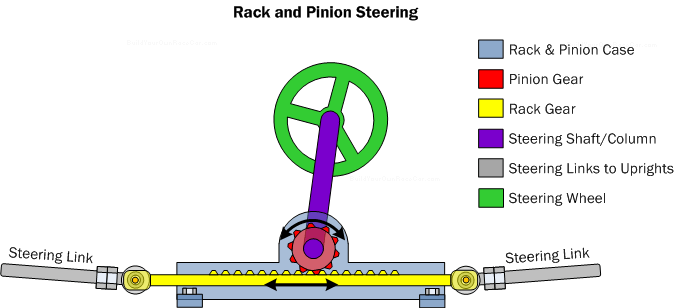
Diagram ST1. Rack and pinion steering system. The steering links connect to wheel uprights/knuckles.
Meshed to the rack is a circular gear (the “Pinion”) which is attached to the steering wheel via a shaft. When the driver turns the steering wheel, the pinion gear turns and moves the rack either left or right. This in turn moves the steering links left or right and because they are connected to the upright/knuckle, the wheel and tire change their angle.
The advantage of rack and pinion is its simplicity and light weight, both of which are desirable in a race or sports car’s design. The Recirculating Ball system is more compact than the rack-and-pinion, but it is usually heavier. Some vehicles use Recirculating Ball, especially production-based trucks and cars.
Steering systems can also come with power-assist which provides most of the effort to steer the vehicle. Power assist is provided by a hydraulic pump driven by the engine. When the driver turns the wheel, valves within the steering system use the hydraulic pressure to assist in moving the steering gears.
Despite making the driver’s job easier, the use of power assist has been noted to reduce the “feel” feedback of the vehicle’s handling through the steering system. Power-assist also adds weight, but despite this, it should be considered for vehicles where steering effort is large or the duration of racing or driving is long (i.e. Endurance).
Suspension Characteristics and Geometry
Unsprung Weight
Unsprung weight is a measurement of the weight of everything outboard of the wishbones or suspension links, plus 1/2 of the weight of the wishbones or links and spring/shock. It therefore usually includes the tire, wheel, brake, knuckle/upright and 1/2 of the suspension links/wishbones. It has a significant effect on handling. Diagram UW1 below demonstrates why unsprung weight is so important:
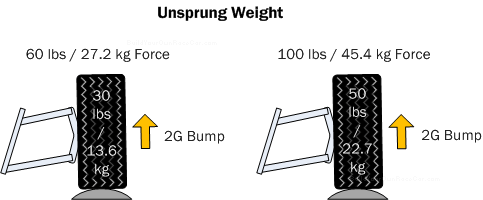
Diagram UW1. Unsprung weight is best kept to a minimum to avoid upsetting the balance of the vehicle.
As the diagram shows, the more weight outboard of the car, the more force a bump will exert on the suspension (and ultimately the chassis). The unsprung weight on the left is 30 lbs (13.6 kg) and when the tire encounters a 2G (2 x gravity) bump, it applies 60 lbs (27.2 kg) of vertical force into the suspension. Even worse, the unsprung weight of the suspension on the right is 50 lbs (22.7 kg) and when the tire encounters a 2G bump, it applies 100 lbs (45.4 kg) of vertical force.
This force is handled using springs, dampers and anti-roll bars, but inevitably the force is transmitted into the chassis. Therefore, the more “upward” force, the more difficult it is to keep the tire planted on the road. This is especially true of lighter weight cars. In the example above, if the car weighs 1000 lbs (454 kg), a 2G bump would result in a vertical force of 10% of the car’s weight.
This will at the very least reduce the grip of the car because the upward inertia created by the bump will reduce the weight on the tire briefly after encountering the bump. As the vertical load on the tire dictates how much traction it produces, some traction will be lost.
Kingpin Inclination
Kingpin Inclination provides steering feel and affects the effort required to steer the car. In the front view diagram KP1 below, the red line on the right represents the center line of the tire/wheel. The red line on the left represents the kingpin inclination line, which runs through the upright/knuckle attachment points. The angular difference between the two red lines is the angle of the kingpin inclination.
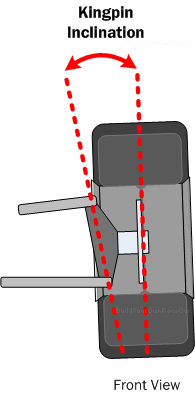
Diagram KP1. Kingpin inclination
Scrub Radius
Scrub radius is the distance from the centerline of the tire/wheel to where the kingpin line intersects with the road surface. The larger the distance, the more effort is required to turn the wheel, as the tire has to “scrub” slightly to turn around the kingpin axis. Diagram SR1 below shows a red dimension to indicate the scrub radius.

Diagram SR1. Scrub radius
Camber
Camber is the angle between vertical (90° perpendicular to a flat road surface) and the “lean” of the tire/wheel. In diagram CAM1 below, negative camber of about 2 or 3 degrees is shown. Depending on the suspension type, camber can change as the wheel/tire rises and falls with suspension movement. If the geometry of the suspension is well designed, the camber change will be optimized to keep the contact patch of the tire as large as possible, providing the most grip possible. Generally speaking, the contact patch and grip begin to decrease as soon as the camber exceeds a small amount, either positive or negative.
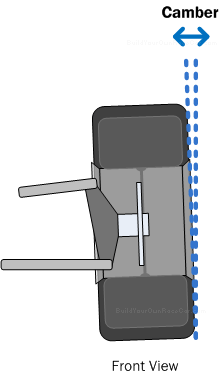
Diagram CAM1. Wheel camber
Toe In/Out
Toe-In or Toe-out is a slight angle of a wheel/tire measured from a line running longitudinally (along the length of the vehicle). Diagram T1 below shows an exaggerated version of toe from a perspective of looking down onto the wheel/tire from above. Toe-in has the wheel/tire steering slightly toward the center of the vehicle. Toe-out has the wheel/tire steering slightly away from the vehicle center.
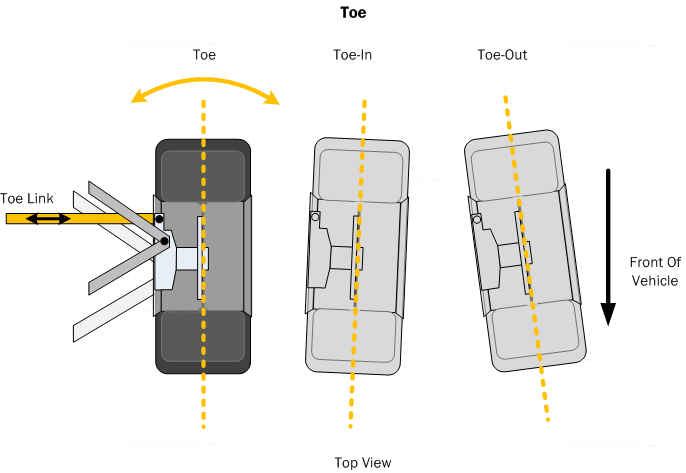
Diagram T1. Toe. The amount of toe is changed via a toe link (if fixed) or steering link (if steered)
Toe-in/out can be used to offset the natural change in toe position caused braking and acceleration and to assist a vehicle with corner turn-in.
Caster
Caster is the angle, measured from vertical (90° perpendicular to a flat road surface), of a line that runs through the mounting points of the upright/knuckle, when viewing the wheel/tire from the side. Diagram CAS1 below shows the Caster line running through the upright mount points.
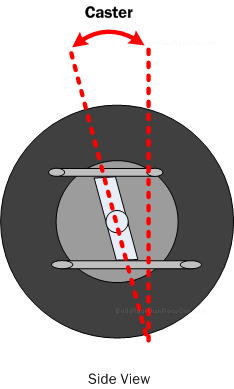
Diagram CAS1. Caster
This angle is used to create a gyroscopic effect on steering. This can be demonstrated by turning the steering wheel in a vehicle and then letting go of the wheel. The caster causes the steering to correct itself back to straight ahead, instead of turning, without the need for driver input.
Suspension Design Tips (3/4)
Use strong high-quality hardware
Suspension components, especially fasteners and rod ends can be expensive. However, they are absolutely critical not only to safety, but success. You should use best practices for joint design–Using a good component in a poorly mounted way is no better than using a poor component in the first place. Strength and durability requirements should always be considered relative to the vehicle and anticipated loads.
34 1 38 2


